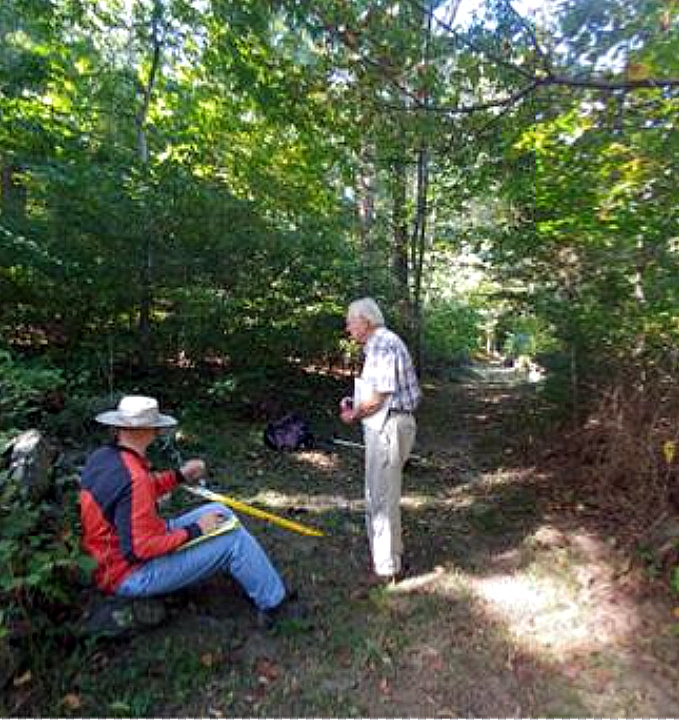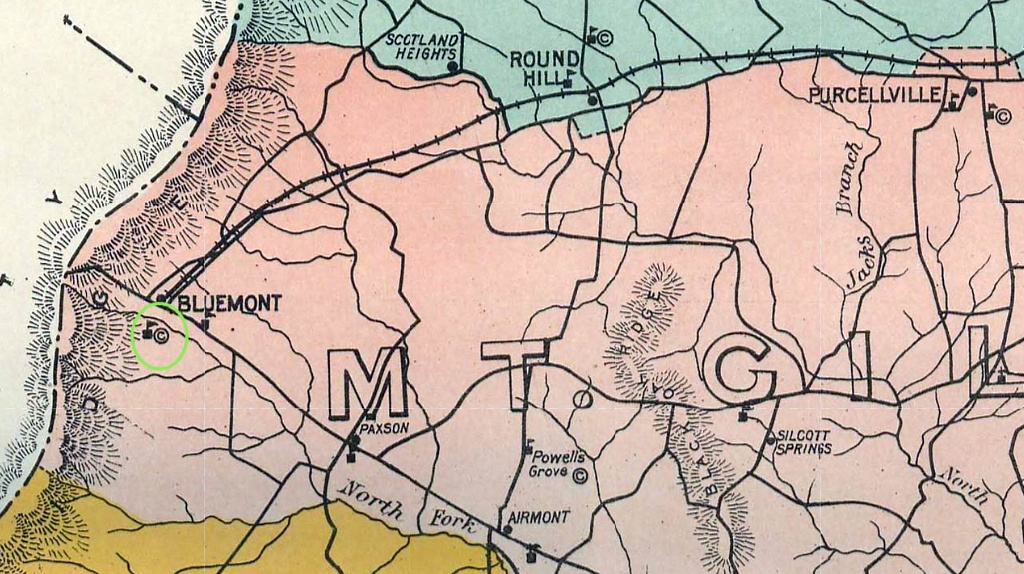Bluemont Colored
Opening and Closing
Created/Opened: 1878. See deed from Benjamin Young to the Mt Gilead School District, dated 22 April 1878. Closed: AY 1932/33.
The property is still owned by LCPS, as of 2021 when Larry Roeder and Tony Arciero mounted an exploratory expedition.
Physical and Map Location
Location: In the Mt. Gilead District during segregation, Now in the town of Bluemont in the Blue Ridge District. It is a .25 acre site – reference Loudoun PIN 649-48-9304. Title To Bluemont Colored School Property. The school property is just south of Snickersville Turnpike and SE of Bluemont Village Lane.
Property: It is a .25 acre site – reference Loudoun PIN 649-48-9304. Title To Bluemont Colored School Property. The school property is just south of Snickersville Turnpike and SE of Bluemont Village Lane. As of 2021, the property is still owned by LCPS.
To the east of Bluemont on Snickerville Turnpike is also a rare standing example of a former home of a Black teacher, in this case, Beatrice Scipio, now privately owned. The address is 18556 Foggy Bottom Road. More on Scipio is found in section on Teachers and the PTA.
Petitions
The Black community recognized that they had rights under the U.S. Constitution to petition for improvements. For details on how petitions were used in general, go to the Petitions Page.
1934: Petition. Parents from Bluemont wrote to the School Board on Oct 3, 1934 taking note of the fact that the school had been closed, due to the size of attendance which make Bluemont an “illegal school,” though the exact date of closure wasn't provided. “In view of this condition, we, the patrons of the Bluemont colored school, are asking the Loudoun County Board of Education to give us transportation for seven pupils to Rock Hill School, with the teachers, as she passes through Bluemont going from Purcellville to Rock Hill school. We the undersigned persons believe that this request is reasonable.” Signed by eleven patrons. (Source: EWP: 2.5A Yr 1934 Bluemont Needs transport to Rock Hill.)
Transportation
See Petitions. Walking was a common method of school transportation even before the creation of Loudoun County Public Schools (LCPS). It’s believed that students who lived within 3 miles of a school could walk from their home to school. The figure at https://edwinwashingtonproject.org/admin/item/31119 shows the location of the school with a circle representing the area from which students could have walked, back and forth from their home to the school. Travel by horse was also used and could have extended the travel distance.
History
1878: Constructed
1930: The Loudoun County School Board decided on 10 July 1930 to consider at its next meeting (August 4th) to close Bluemont, due to lack of attendance. Source: Washington Post Staff. (11 July 1930). Loudoun Reelects School Officials. Washington Post, p. 20.
1930: Aug 7th. School Board decided to defer decision until September. See EWP 2.2 Yr 4 Aug 1930, School Board.
Instructors
- 1893/94 Academic Year: J. Walter Brown of Silcott Springs was a “colored” instructor who operated on a second grade certificate and Ms. Susan S. Fox of Snickersville instructed on a third grade certificate. Source: Lists of Teachers, 1892-1975 (Census of Colored Teachers 1893/94 – March 30, 1894), Richmond, Virginia, USA: Virginia Department of Public Instruction/Education.
- 1894/95: Miss Susan S. Fox and Mr. J.F. Roberts, both of Snickersville, instructed on third grade certificates: Source: Lists of Teachers, 1892-1975 (Census of Colored Teachers 1894/95 – Done Dec 10, 1894), Richmond, Virginia, USA: Virginia Department of Public Instruction/Education.
- 1895/96: No records.
- 1896/97: Mr. Roberts continued to instruct on 3rd grade certificate. Source: Lists of Teachers, 1892-1975 (Census of Colored Teachers 1896-97 – Done Dec 15, 1896), Richmond, Virginia, USA: Virginia Department of Public Instruction/Education.
- 1917/18: Pearl Shirley of Herndon. 3 years of experience.
- 1920/21 1928/29 Beatrice B. Scipio. “One of Christopher and Rose’s children was Beatrice Scipio (1892-1978) who earned a teaching degree from Storer College in Harper's Ferry, West Virginia in 1910. Shortly thereafter she began a 46 year teaching career, during which she taught at the Bluemont ―Colored School on the mountain near Butcher's Branch until it closed in 1933. Later she taught at the George Washington Carver School in Purcellville where she ended her teaching career in 1957. Scipio was well respected in her community and frequently taught children in her home. In addition to teaching, Scipio served as the music director and longtime deaconess of the First Baptist Church of Bluemont. She died in 1978 and was buried in the Scipio family plot in the Rock Hill Cemetery north of Unison. Source: Loudoun County African-American Historic Architectural Resources Survey, September 2004.
- 1929/30 – 1930/31. Milda M. Smith. Born July 3, 1900. Lived in Elberon. Graduated from Hampton Institute and Petersburg.
- 1931/32 Martha M. Branche. Born 5/31/1911. Lived in Washington, DC. Graduated from Dunbar High School and Miner Teacher's College, Washington, DC. Only instructed the one year in Loudoun.
Note: Dunbar was named after Paul Laurence Dunbar, an American poet, novelist, and playwright of the late 19th and early 20th centuries
Insurance and Physical Description
1927 Perhaps not insured by LCPS system, though the white school was. We surmise this because while the school for Blacks was listed that year, the citation was left blank. See Insurance Record. Purcellville: EWP 11 (1923-1961) Page 32/33.
1931-1933. The school building was insured for $66 each year Fireman's Trust, Rhode Island and Va. Fire and Marine Trust. See EWP 11 (1923-1961) Page 80/81. 1932/1933 was the year the building closed. The contents of the building may have continued to be insured 1934/36. See EWP 11 (1923-1961) Page 90/91.
We have not found any contemporary photographs of the Bluemont school, other than a faint shot from a great distance, which might be of an adjacent building. However, a large number of photographs of the overgrown site were developed during a survey expedition in August, 2017 by Larry Roeder, Tony Arciero and Henry Plaster. They also located the remains of a Black church. See Finding the BlueMont Colored School2
Construction Material. Wood frame. Metal roof. One room only. The state of repair in the 1920’s was considered good to fair. As of 1924/25, term reports did not document this condition. There are no reports covering the period prior to 1920. Building is now a ruin, leaving only bits of foundation, glass and roofing. In the past some of the lumber was transported to the main part of the village of Bluemont(former Snickersville) for a veterinary clinic.
Blackboard: 40 sq. feet of Virgoplate, a brand made by Virginia School Supply in Richmond and guaranteed for ten years of use. Virginia School Supply also provided chairs, window shades, teacher desks and chairs, disinfectant, sweeping fiber, slated cloth, book cases, maps and many other items.
Plumbing: Probably well water.
Electricity: None during segregation was mentioned in records.
Heated by wood.
Ventilation was by “lowering the window.”
Outhouse(s) or toilets: Sanitary. Location TBD. As of 1920, their condition was considered good. Sanitary outhouses were different from older, traditional ones in that waste was dropped into a deep vault and usually covered with lime.

